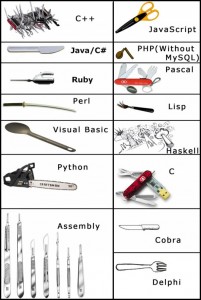
One of my earliest programming mentors introduced me to the concept of dependency injection and inversion of control, commonly shortened to DI/IOC, in my first year of my first real job as a professional programmer. This individual was known in the group for “pushing the envelope” of technologies and processes that we used to write software. They were also known for championing Ruby (right around the time of the original release of Ruby on Rails), promoting test driven development, and taking hours off to go shopping for shoes during the workday at a rather large global financial juggernaut (see my resume on LinkedIn if you’re curious about who this employer might have been). Dependency injection, at the time, was described to me as something which would “bring my code out of the dark ages” by eliminating reams of poorly written (and often “wrong”) singleton management and lifecycle management code. (I use the term “wrong” in the sense that Java Concurrency in Practice uses when it talks about how, for example, using the double-checked locking idiom for lazy initialization in Java without the volatile keyword is “wrong”.) As a wide eyed newbie programmer listening to a relative “god”, I was enamored with the power of DI and became a life-long convert.
Why is DI powerful?

There are literally hundreds, likely thousands, of articles, StackOverflow questions, blog posts, forum threads and other resources which speak about the merits of dependency injection and some of the frameworks which implement it. My goal with this post is not to provide a comprehensive treatment of why one should use DI, but rather to provide samples from my own personal experience to add to the conversation.
That being said, some online resources that seem good include:
DI frameworks – Scala with Spring
In joining a new group at my current job, I stepped into a role as a software engineering lead and have recently found myself explaining the merits (and pitfalls!) of DI frameworks to un-initiates / skeptics. I should note that those who view DI frameworks with skepticism are not bad programmers by any means; on the contrary, they often write high quality, concise code. If anything, I myself suffer from the curse of knowledge regarding DI frameworks – Spring in particular. But much like my experience (and many other’s experiences) with technologies and methodologies that vary in “power”, technologies and methodologies “less powerful than [x] are obviously less powerful, because they’re missing some feature [they are] used to.” (I’m quoting from Paul Graham’s post on the power of languages, but I think the same argument works here for software design frameworks.) Again, I’ll quote (with some pronoun adjustments): “when our hypothetical [x] programmer looks in the other direction, up the power continuum, they don’t realize they are looking up. What they see are merely weird [technologies]. They probably consider them about equivalent in power to [x], but with all this other hairy stuff thrown in as well. [x] is good enough for them, because they think in [x].” In short, DI frameworks often looks as powerful as managing your own object graph and lifecycle but filled with lots of “hairy stuff thrown in as well” which seems superfluous – why should one go the trouble?
Regarding Spring as a DI framework – my opinion is that Spring is one of the best DI frameworks for the Java-based ecosystem. If you’re raising your eyebrows, I’m not surprised – over the many years that I’ve used DI frameworks, I’ve often gotten strange looks because I promote the use of Spring’s DI container. Most of the conversations that I have with Spring skeptics revolve around some basic mis-understandings of the framework itself. Let me try to set the record straight.
- Spring is not based on XML anymore. Yes, you can technically use bloated XML to configure your apps, but it is by no means the preferred way nor do savvy programmers do this anymore. Using standard Java DI annotations or Guice-style code wiring is now the preferred DI wiring mechanism in Spring.
- Using Spring DI does not force you to tie your program code to Spring. As you’ll see below, usage of Spring DI requires either one or two Spring import statements in one isolated section in code, completely separate from your application logic. This is on par with Guice. Spring does NOT marry you to the framework – ripping it out and replacing it with another DI framework will takes on the order of seconds, and requires zero refactoring.
- Using Spring does not force you to import many libraries. Only one library is required (the spring-context library).
OK, I hope that’s all out of the way. Now, I’ll take a brief moment to highlight some of Spring’s benefits:
- Spring DI is an incredibly well-tested, widely-used, and robust framework that has been around for over a decade. It is rock solid and I’d guess that most of it’s bugs have been excised long ago.
- Spring DI supports standard Java specification annotations for DI (JSR 330 – the javax.inject package), if you wish to use them. This enables removal of all code-based DI (which is required with frameworks like Guice). This isn’t manadatory, but it is possible.
- Spring DI supports standard Java specification annotations for lifecycle management (JSR 250 – the javax.annotations package), if you wish to use them. This enables the DI container to manage proper startup and shutdown of your classes (in case they are stateful). Think about thread pools, database connections, in-flight computations, and other long-lived entities. I have not seen any other Java DI framework implement lifecycle management “correctly”. For example, Guice’s maintainers have decided that lifecycle management is not important.
- Other Spring framework components – JDBC helpers, thread pool management, AOP, Web / REST, and others – are very easily integrated into the Spring DI. They are by no means required, but benefits of using Spring DI and other Spring components together are greater then using them alone.
I am fully aware that there are numerous other DI frameworks on the market, both for Java and for Scala. I think some of them (notably Guice and Subcut) have very good points about them. However, I feel that they are not as robust as Spring’s DI offering, and this is why I am not highlighting their usage. I will leave a separate discussion of Spring vs other DI frameworks for another times.
I’ll continue this discussion based on sample code (https://github.com/dinoboy197/sailing-cruise-watcher) that I wrote using Scala and Spring together. The code was originally written to monitor a 2000s-era website for reservations availability for sailing classes, but that’s a different story entirely.
DI-enabling classes
Creating your own classes
It is easy to DI-enable a class so that Spring will create an instance of it for injection into other classes and for lifecycle management. Simply add the javax.inject.Named annotation to the class:
import javax.inject.Named
@Named
class SampleProcessor {
Now, Spring will create and manage a single instance of the SampleProcessor class in your program; it can be injected anywhere.
To inject an instance of a class that you’ve annotated with @Named into a different class, use the @Inject annotation:
import javax.inject.Inject
import javax.inject.Named
// mark a class with @Named to create an instance of it in the object graph
@Named
// use @Inject() followed by constructor arguments to have Spring wire in instances of these classes
class SailingCruiseChecker @Inject() (val http: Http, val sampleProcessor: SampleProcessor) {
See that for the class SailingCruiseChecker, two other class instances are being injected: an instance of a SampleProcessor class and an instance of an Http class.
Managing class instance lifecycle
Some class instances are stateful; they may even require special handling during startup or shutdown. A startup example: a class may need to pre-load data from a dependent class before it can service its public methods; however, its dependent classes must be wired up before this happens. A shutdown example: a class may need to wait before exiting to properly close a thread pool, close JDBC connections, or save in-flight computations for proper continuation upon restart.
To specify a method which is called once automatically after the object graph is created, annotate it with javax.annotation.PostConstruct. To specify a method which is called once automatically before the object graph is torn down (either due to JVM shutdown or DI container closing), annotate it with javax.annotation.PreDestroy.
// if your singleton has some state which must be initialized only *after* the object graph is constructed
// (ie, it calls other objects in the object graph which might not yet be fully constructed)
// use this method
@PostConstruct
def start() {
// some initialization that is guaranteed to only happen once
}
@PreDestroy
def stop() {
// if your singleton has some state which must be shut down to cleanly stop your app
// (ex: database connections, background threads)
// use this method
}
Managing third-party library class instances with Spring
Using libraries is common, and it’s easy to instantiate third party classes which are not DI-enabled within any code that you write. Take, for example, a class in a third party library called NonDIEnabledClass which has an initialization method called init() and a method to be called for cleanup before JVM shutdown called close():
// this is a fictitious example of such an external class which must be started with init() and stopped with close()
class NonDIEnabledClass {
def init {}
def doSomething{}
def close {}
}
Using this class in code might look like the following:
@Named
class Http {
private val httpHelper = new NonDIEnabledClass()
@PostConstruct
def start() {
httpHelper.start()
}
def get(url: String): String = {}
@PreDestroy
def init() {
httpHelper.stop()
}
}
The Http class is tightly coupled to the NonDIEnabledClass and is quite non-DI-like.
During testing (class, unit, or even end-to-end integration tests), it can valuable to stub behaviors at your program code boundaries – for instance, stubbing out the behavior of the NonDIEnabledClass above. Mocking frameworks can use fancy JVM bytecode re-writing techniques to intercept calls to new and swap in stubs at test time, but we can easily avoid JVM bytecode re-writing by managing third party library classes with Spring.
First, instruct Spring to create and manage an instance of this non-DI-enabled class. Declare a new configuration class in which you’ll add a method annotated with org.springframework.context.annotation.Bean (here the configuration class is named Bootstrap, though the name is irrelevant):
// configuration class
// used for advanced configuration
// such as to create DI-enabled instances of classes which do not have DI (JSR 330) annotations
class Bootstrap {
// use @Bean to annotate a method which returns an instance of the class that you want to inject and of which
// Spring should manage the lifecycle
@Bean(initMethod = "init", destroyMethod = "close")
def externalNonDIEnabledObject() = new NonDIEnabledClass()
}
Note how the optional initialization and teardown methods can be specified as parameter values to the Bean annotation as “initMethod” and “destroyMethod“.
Now, wire the instance of this class in where it is desired, for instance, in our Http class from above:
@Named
// see the Bootstrap class for how non-DI annotated (JSR 330) objects make their way into the object graph
class Http @Inject() (val externalNonDIEnabledObject: NonDIEnabledClass) {
def get(url: String): String = {}
}
Note the differences between the former and latter examples of the Http class. In the latter example:
- The
Http class does not use new to instantiate the NonDIEnabledClass.
- No
@PostConstruct nor @PreDestroy methods are necessary in the Http class to manage the lifecycle of the NonDIEnabledClass instance.
Activating Spring DI
Your code is now wired up and ready for execution. Spring DI now needs to be activated.
Having now seen concrete examples of how to DI-enable your classes, let’s return to a Spring app’s lifecycle:
- Instantiate any classes annotated with
@Named
- Inject these instances into
@Inject points on your classes
- Execute all
@PostConstruct methods on these instances
- Wait for the DI container shutdown (which can happen automatically at JVM shutdown via shutdown hook).
- Execute all
@PreDestroy methods on these instances
To activate Spring, create an instance of an org.springframework.context.annotation.AnnotationConfigApplicationContext, scan the package containing your DI-enabled classes, refresh the context, start the context, then register a shutdown hook. In this example, this code is located in an object called Bootstrap, which extends App for direct execution when Scala starts up (see more on this in a moment).
// main entry point for command line operation
object Bootstrap extends App {
// start up the Spring DI/IOC context with all beans in the info.raack.sailingcruisechecker namespace
val context = new AnnotationConfigApplicationContext()
// include all DI annotated classes in this project's namespace
context.scan("info.raack.sailingcruisechecker")
context.refresh()
// start up the app - run all JSR250 @PostConstruct annotated methods
context.start()
// ensure that all JSR250 @PreDestroy annotated methods are called when the process is sent SIGTERM
context.registerShutdownHook()
}
If you’ve included a class definition for the Bootstrap class to manage the lifecycle of third party class instances, you’ll also need to register these instances. Add a register(classOf[Bootstrap]) call to the definition above:
// start up the Spring DI/IOC context with all beans in the info.raack.sailingcruisechecker namespace
val context = new AnnotationConfigApplicationContext()
// include all custom class instances which are not DI enabled
context.register(classOf[Bootstrap])
// include all DI annotated classes in this project's namespace
context.scan("info.raack.sailingcruisechecker")
Starting your app
We’re ready to start our app! I’ll assume use of the sbt build system for this Scala program.
First, include the Spring libraries that you’ll need for DI in the build.sbt file. This includes spring-beans and spring-context. I also like to use slf4j as a logging facade and logback as a logging backend, and since Spring still uses commons-logging as a backend, I redirect commons-logging into slf4j with jcl-over-slf4j and then include logback as the final backend.
// libraries
libraryDependencies ++= Seq(
"org.springframework" % "spring-context" % "4.1.6.RELEASE" exclude ("commons-logging", "commons-logging"),
// spring uses commons-logging, so redirect these logs to slf4j
"org.slf4j" % "jcl-over-slf4j" % "1.7.12",
"org.springframework" % "spring-beans" % "4.1.6.RELEASE",
"javax.inject" % "javax.inject" % "[1]",
// logging: log4s -> slf4j -> logback
"org.log4s" %% "log4s" % "1.1.5",
"ch.qos.logback" % "logback-classic" % "1.1.3"
)
Next, I’ll indicate the main class for starting up the program. You may want to do this if you choose to bundle all of your code and third party libraries together with the assembly plugin or something similar.
// main class
mainClass in (Compile, packageBin) := Some("info.raack.sailingcruisechecker.Bootstrap")
Finally, start up the app:
sbt run
If all is well, Spring should be started and your app will run!
Read More






